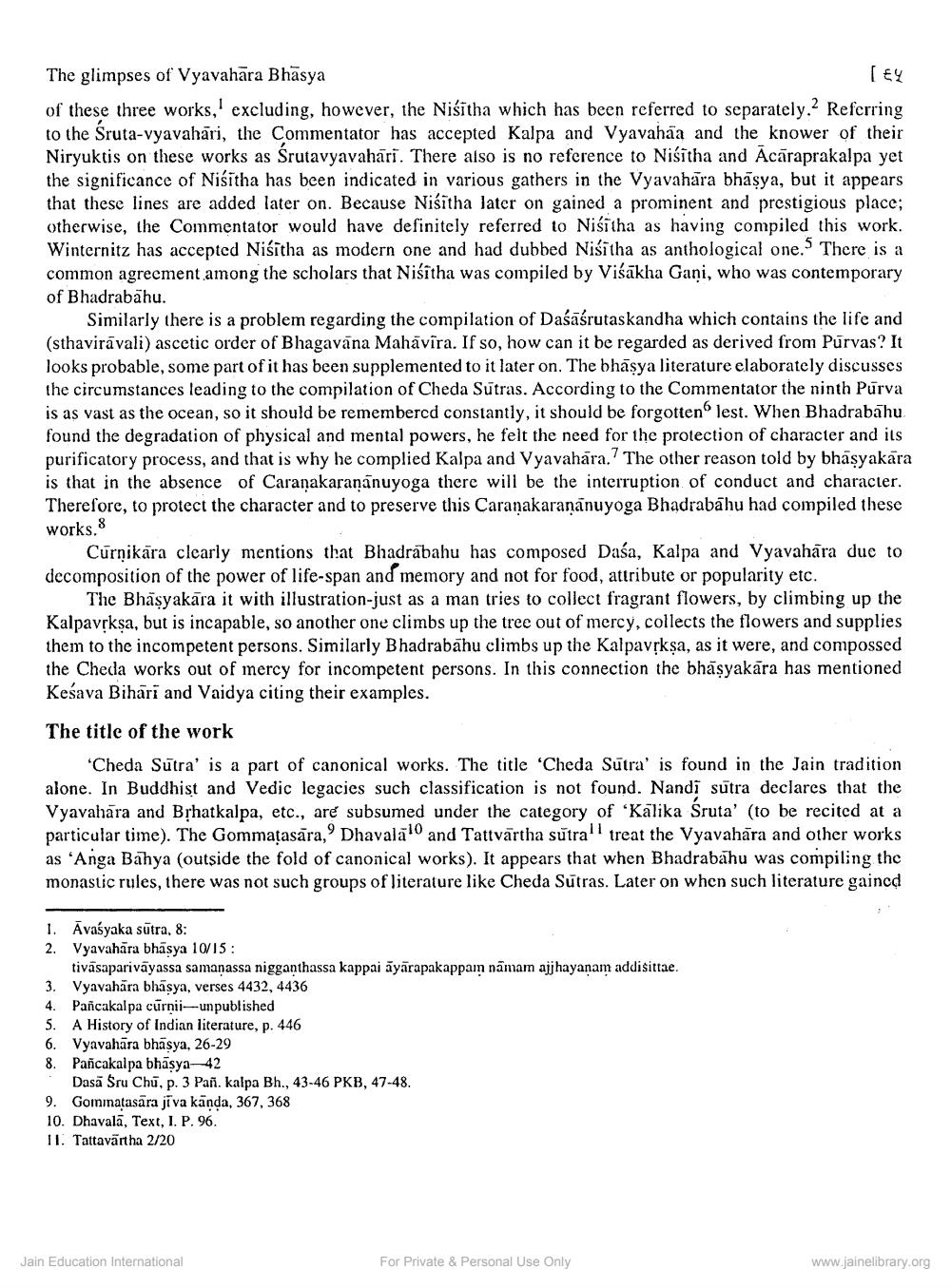________________
The glimpses of Vyavahāra Bhäsya
TEL of these three works,' excluding, however, the Niśītha which has been referred to separately.? Referring to the Sruta-vyavahāri, the Commentator has accepted Kalpa and Vyavahaa and the knower of their Niryuktis on these works as Srutavyavahari. There also is no reference to Niśitha and Acāraprakalpa yet the significance of Niśitha has been indicated in various gathers in the Vyavahara bhāsya, but it appears that these lines are added later on. Because Niśitha later on gained a prominent and prestigious place; otherwise, the Commentator would have definitely referred to Nišitha as having compiled this work. Winternitz has accepted Niśitha as modern one and had dubbed Niśītha as anthological one. There is a common agreement among the scholars that Niśitha was compiled by Visakha Gani, who was contemporary of Bhadrabāhu.
Similarly there is a problem regarding the compilation of Daśāśrutaskandha which contains the life and (sthaviravali) ascetic order of Bhagavāna Mahavira. If so, how can it be regarded as derived from Pūrvas? It looks probable, some part of it has been supplemented to it later on. The bhāsya literature elaborately discusses the circumstances leading to the compilation of Cheda Sutras. According to the Commentator the ninth Purva is as vast as the ocean, so it should be remembered constantly, it should be forgotten lest. When Bhadrabahu found the degradation of physical and mental powers, he felt the need for the protection of character and its purificatory process, and that is why he complied Kalpa and Vyavahāra.? The other reason told by bhāsyakāra is that in the absence of Caranakaranānuyoga there will be the interruption of conduct and character. Therefore, to protect the character and to preserve this Caranakaranānuyoga Bhadrabahu had compiled these
works. 8
Curnikāra clearly mentions that Bhadrabahu has composed Daśa, Kalpa and Vyavahāra due to decomposition of the power of life-span and memory and not for food, attribute or popularity etc.
The Bhasyakāra it with illustration-just as a man tries to collect fragrant flowers, by climbing up the Kalpavrkșa, but is incapable, so another one climbs up the tree out of mercy, collects the flowers and supplies them to the incompetent persons. Similarly Bhadrabahu climbs up the Kalpavřksa, as it were, and compossed the Cheda works out of mercy for incompetent persons. In this connection the bhāsyakāra has mentioned Keśava Bihari and Vaidya citing their examples.
The title of the work
"Cheda Sutra' is a part of canonical works. The title 'Cheda Sutra' is found in the Jain tradition alone. In Buddhist and Vedic legacies such classification is not found. Nandi sutra declares that the Vyavahara and Brhatkalpa, etc., are subsumed under the category of 'Kalika Sruta' (to be recited at a particular time). The Gommațasāra, Dhavala! and Tattvārtha sūtrall treat the Vyavahāra and other works as 'Anga Bahya (outside the fold of canonical works). It appears that when Bhadrabahu was compiling the monastic rules, there was not such groups of literature like Cheda Sutras. Later on when such literature gained
1. Avasyaka sūtra, 8: 2. Vyavahāra bhāsya 10/15 :
tivasaparivāyassa samanassa nigganthassa kappai āyārapakappam nāmam ajjhayanam addisittae. 3. Vyavahāra bhāsya, verses 4432, 4436 4. Pancakalpa curnii-unpublished 5. A History of Indian literature, p. 446 6. Vyavahāra bhāsya, 26-29 8. Pancakalpa bhāsya-42
Dasa Sru Chu, p. 3 Pan. kalpa Bh., 43-46 PKB, 47-48. 9. Gominatasära jiva kanda, 367, 368 10. Dhavala, Text, I. P. 96. 11. Tattavārtha 2/20
Jain Education International
For Private & Personal Use Only
www.jainelibrary.org




